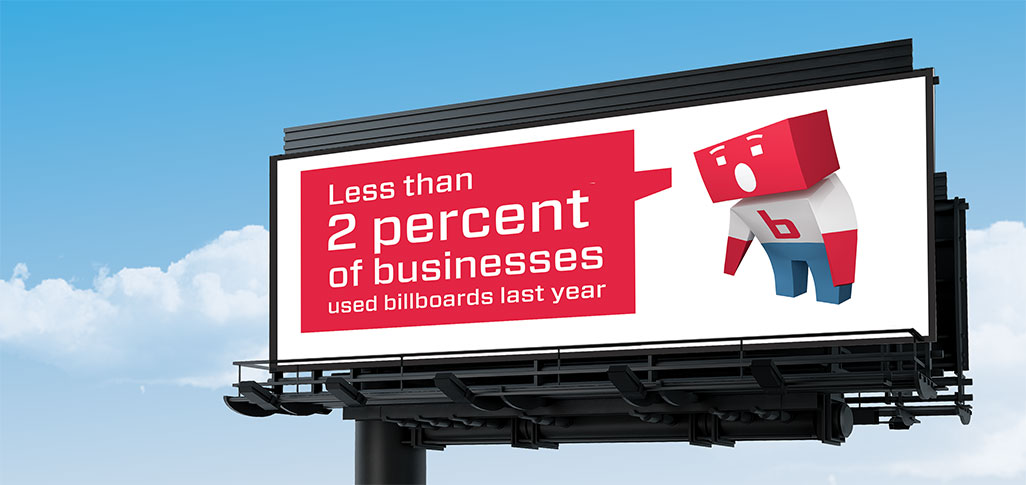
Experts believe that Americans are exposed to 4,000 to 10,000 advertisements per day! The challenge for brands to cut through the noise and make an impact on the consumer is immense. Surprisingly, in our increasingly digital world, it’s Out-of-Home (OOH) advertising that is becoming the vehicle brands can use to drive home their message.
Outdoor advertising offers companies great visibility, a captive audience and a medium to deliver your message that consumers equate to one reserved for big brands. A recent study found that 75 percent of U.S. adults notice outdoor ads.
Today, no one advertising channel works alone and outdoor ads dovetail nicely with other mediums to create a holistic marketing campaign. In a European study, researchers found that 38 percent of people visited a specific Facebook page after viewing an ad and that 25 percent sought out the brand on Instagram. Overall a mix of outdoor ads and social media resulted in a campaign that was 13 percent more effective than social channels alone.
“OOH is as relevant as ever because it offers high impact and amplifies all other media investments, including today’s largest ad channel – digital,” said Stephen Freitas, Out of Home Advertising Association of America’s chief marketing officer. “ROI, media mix optimization, and attribution research all prove OOH’s worth in today’s highly-competitive advertising environment.”
In 2018, OOH advertising was the only traditional advertising tool to show growth. Over $8 billion was spent on OOH in 2018 and that number has grown quarterly for the past 35 quarters.
While digital and mobile advertisement is prized for its ability to have a consumer click through to purchase, OOH advertising is about building larger brand awareness and name recognition. The rule of seven in advertising states that a person needs to see your brand at least seven times before it makes an impression. Outdoor ads can help boast your offline recognition making it more likely your customer remembers you when they’re online or in a store ready to purchase.
To build brand awareness using billboards, it’s imperative to pick high-traffic locations where your target consumer is apt to see your message. The more creative and uniquely designed your ad the more attention and impact it will have.
One new take on traditional billboard advertising is the rise of digital billboards. According to PWC, digital outdoor ad spending will eclipse spending on traditional billboards by next year. Spending on digital OOH has grown 35 percent since 2010. According to research, 52 percent of Americans say they’ve seen a digital sign in the past week and 55 percent recall the specific message. Four out of five brands that have used digital signs saw a 33 percent increase in sale after doing so.
Digital OOH opens up a host of new ways to get creative. Ads can be specifically tailored to location. For example on a crowded highway, McDonald’s ran an ad proclaiming there was light at the end of the tunnel and simply used their logo. Using digital billboards, a brand could create messaging for specific times of day or tailored to specific outcomes of an event.
Some digital billboards have software imbedded that can actually tell if consumers turn their heads and look at the advertising. Digital OOH can also be designed to be interactive.
Not only does OOH build brand awareness, it amplifies the success of other marketing efforts. In a study conducted by Rapport, companies that used OOH for brand building and sales activation saw their brand trust ratings increase 26 percent, brand quality rating rose by 106 percent and customer loyalty improved 275 percent. Additionally, OOH boasted the effect of print, radio, TV, online, social and search effects anywhere from 11 to 80 percent.
For companies wanting to build brand recognition and increase the overall effectiveness of all marketing efforts, all signs point to traditional and digital OOH being the ticket to success.
By Brent Thomson, CEO Blip Billboards
Billboard expert Brent Thomson has created a company that could be considered to be the “Vista Print of Billboards”. He has developed an app for his business, Blip Billboards, that allows business owners to create a billboard on their cell phone in less than 5 minutes, place it almost anywhere across the U.S., and, then choose whatever amount of money they want to spend on the campaign ($20 a day, $100 a day ect). Advertisers can create campaigns with the signs, schedules, budget, and designs that they choose — removing the barriers and expense that advertisers so often experience when trying to contract with sign owners.





